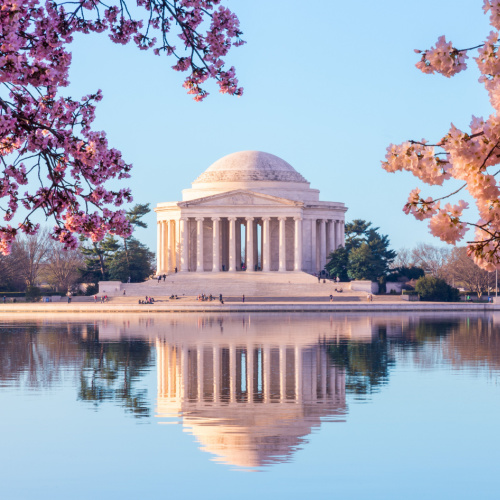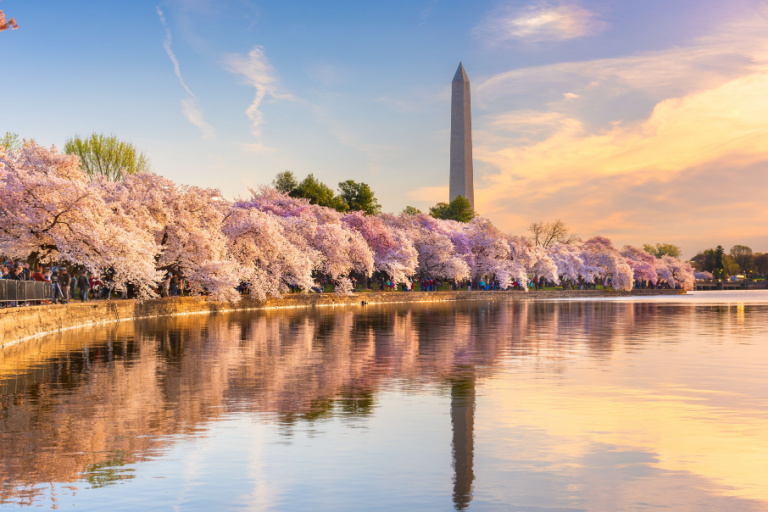
Steve Heap/Shutterstock
When Is the Best Time to Visit Washington DC?
The best time to visit Washington, D.C. is during the shoulder seasons of April to June and September to October. During these months, the weather is generally mild and sunny, with fewer crowds and lower prices than during the peak summer season (July and August).
Here are some of the benefits of visiting Washington, D.C. during the shoulder seasons:
- Mild weather: Washington, D.C. has a humid continental climate, with hot, humid summers and cold, snowy winters. The shoulder seasons offer pleasant temperatures, making them ideal for sightseeing, exploring, and enjoying the outdoors.
- Smaller crowds: The shoulder seasons are less crowded than the peak summer season, so you’ll be able to enjoy Washington, D.C.’s popular tourist attractions without having to deal with large crowds. This is especially important if you’re visiting popular destinations like the National Mall, the Smithsonian Museums, and the White House.
- Lower prices: Prices for flights, accommodation, and activities are generally lower during the shoulder seasons than during the peak summer season. This means you can save money on your trip without having to sacrifice quality.
Here are some specific examples of how you can enjoy the most of Washington, D.C. during the shoulder seasons:
- Spring (April to June): The weather in spring is typically sunny and mild, with occasional showers. This is a great time to visit for the National Cherry Blossom Festival, attending outdoor concerts and festivals, and visiting the many parks and gardens throughout the city.
- Autumn (September to October): The weather in autumn is also typically sunny and mild, with occasional showers. This is a great time to visit for leaf peeping in the Rock Creek Park, attending the Smithsonian Folklife Festival, and visiting the many pumpkin patches and haunted houses throughout the region.
While there are many great times to visit Washington, D.C., if you’re looking for the best weather and the most opportunities to enjoy the city’s many attractions, then we recommend visiting during the shoulder seasons of spring and autumn.
 Average Temperatures by Month
Average Temperatures by Month
|
Jan |
Feb |
Mar |
Apr |
May |
Jun |
Jul |
Aug |
Sep |
Oct |
Nov |
Dec |
| Fahrenheit |
39°
|
42°
|
50°
|
61°
|
71°
|
80°
|
85°
|
84°
|
76°
|
65°
|
54°
|
44°
|
| Celsius |
4°
|
6°
|
10°
|
16°
|
21°
|
27°
|
29°
|
29°
|
24°
|
18°
|
12°
|
7°
|
Climate in Washington DC
Summer Season in Washington DC
Washington, D.C.'s summer season, from June to August, offers hot and humid weather, with temperatures typically ranging from 80°F to 95°F. It's an ideal time for exploring the city's historic sites, enjoying cultural events, and taking in the lush greenery of the National Mall. The hot and sunny weather is perfect for experiencing the nation's capital.
Rainy Season in Washington DC
Washington, D.C. experiences rainfall throughout the year, with slightly more precipitation in the late spring and early autumn months. While there isn't a distinct rainy season, visitors should be prepared for occasional showers, particularly in May and September.
Winter Season in Washington DC
Washington, D.C.'s winter season, from December to February, is relatively cold, with temperatures ranging from 30°F to 45°F. This period is great for exploring museums, government buildings, and historical landmarks without the crowds. It's also a suitable time for enjoying the city's holiday festivities and indoor cultural attractions.
Our Recommendations
| Destination |
Jan |
Feb |
Mar |
Apr |
May |
Jun |
Jul |
Aug |
Sep |
Oct |
Nov |
Dec |
| Washington DC |
 |
 |
 |
 |
 |
 |
 |
 |
 |
 |
 |
 |






